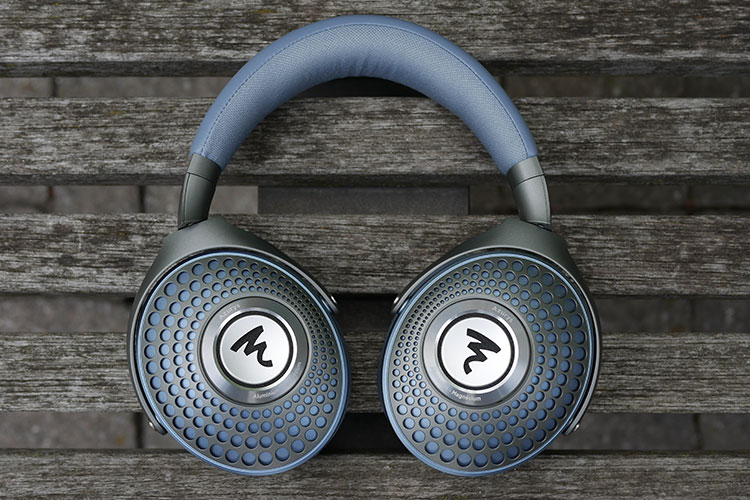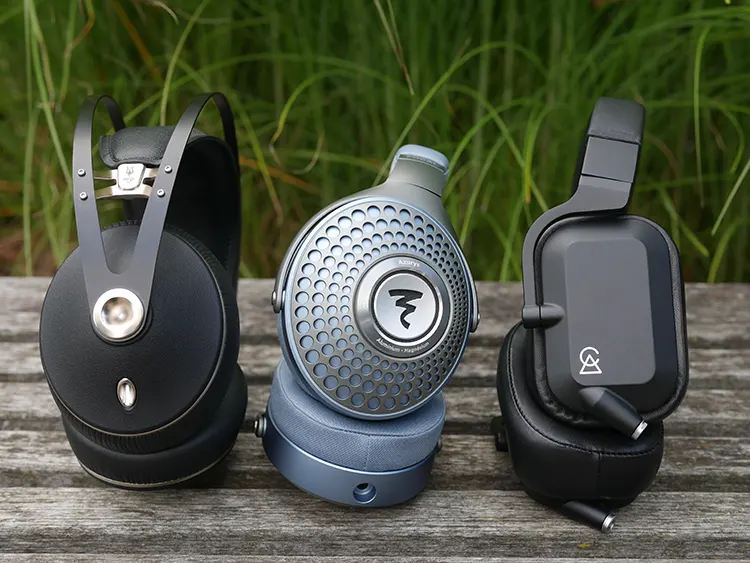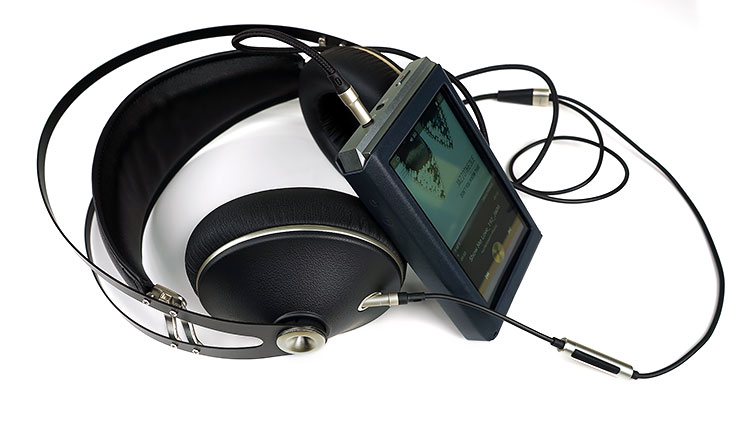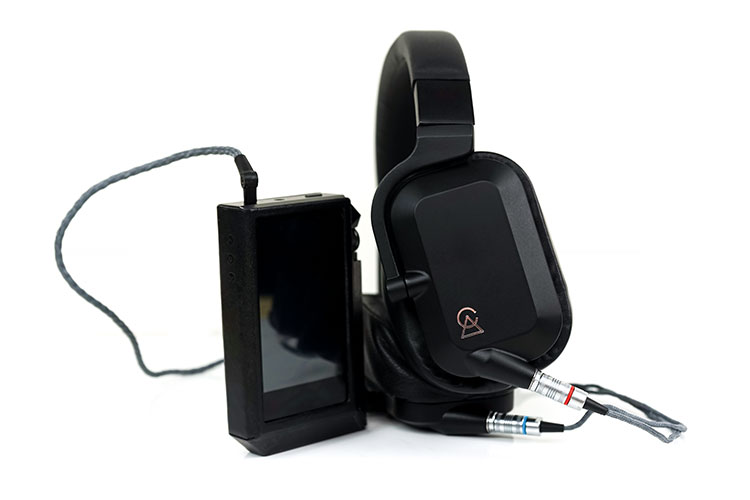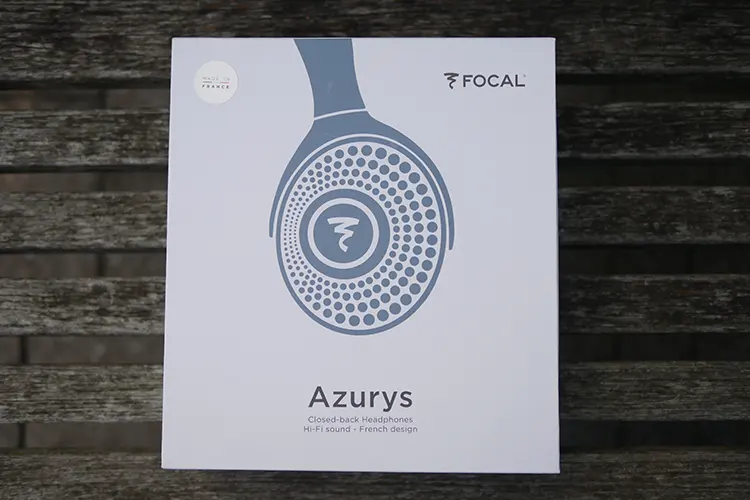Select Comparisons
Meze Audio 99 Neo
Technical
Like the Azurys, the 99 Neo utilizes 40mm dynamic drivers. While the Azurys’ drivers have their patented “M” shaped dome, there is nothing special to note about the 99 Neo’s drivers.
Both products use quality materials. Aluminum, magnesium, real leather, memory foam, and woven fabrics inspire confidence in the Azurys’ longevity.
The 99 Neo uses a stamped manganese steel headband with a self-adjusting pad and cast zinc alloy hardware with an electroplated coating, all of which boost the 99 Neo’s premium feel beyond what its comparatively low price tag would suggest.
It loses points for having less durable protein leather ear pads (mine have started to deteriorate) with a more standard foam, alongside some rattles and ringing caused by the headband.
The 99 Neo is fully serviceable by the owner though, with replacement parts still readily available, a feature few headphone models can boast.
The two take different approaches for their cables, with the Azurys using a single stereo 3.5mm plug with a recessed, but wide port enabling plenty of third-party support. The 99 Neo splits that stereo 3.5mm into two 3.5mm mono plugs that snap into the base of each earcup.
Neither cable is amazing since the Azurys’ rubber sheath is noisy, and the 99 Neo’s cloth sheath is easily tangled, is noisy, and will fray at common bend points, just like every cloth cable ever (I don’t like cloth cables…). The inline mic on the Azurys also sounds much better but is quieter.
The sensitivity of the Azurys is 100dB compared to 103dB for the 99 Neo while the Azurys’ impedance is 26 Ohms compared to the 99 Neo’s 32 Ohms. The 99 Neo is easier to bring up to comfortable listening levels.
Design
Meze’s 99 Neo is based on the 99 Classics, sharing virtually every component. The only major difference is the move to black ABS plastic for the cups.
While you might expect this to be a negative, the matte finish and lightly pebbled texture appeal both to the eye and the hand. And in the hand, you notice the 99 Neo is lighter than the Azurys: 260g vs. 306g.
The steel headband is two slender loops that halo above the wide, self-adjusting pad, connected via light, trident-shaped zinc-alloy brackets, meaning there is no need for a traditional extension mechanism.
The ear cups connect at a single pivot point with gold zinc-alloy accents at the center. Additional accents are found around the 3.5mm ports and the edge of the cup.
It is an elegant, understated design with a timeless appeal. In contrast, the Azurys is bold and exciting and appeal to a more modern audience.
This is especially evident in the brilliant blue and grey colorway of the Azurys. Where the 99 Neo’s dark colors let it blend in, the Azurys stand out and draw the attention of others.
Adding to this is the earcup design which is packed with features. From the bold logo centered in the cup to the surrounding holes through which the azurite-inspired blue shines, there is little that you could say is subtle about the Azurys’ design.
Although the 99 Neo’s cup design lacks the articulation of the Azurys, I still found it to be the more comfortable product. The clamping force is lighter, the head pad is wider, the floating design removes all pressure, and the opening for the ears is more spacious.
It also provides more isolation, helped greatly by the leatherette pads. They don’t breathe though, making for a much warmer wearing experience.
Bass Performance
While the Azurys is not lacking in the low end, the 99 Neo is notably bassier. The Azurys offer a tighter presentation with a quicker attack and decay and better balance between mid- and sub-bass regions.
The 99 Neo brings sheer quantity with a big mid-bass bloom that adds warmth but bleeds into the lower mids. It also provides more visceral feedback on the deepest notes, giving it a more engaging and energetic low end overall, though one that is more of a focal point than on the Azurys.
Texturing and detail levels are similar, with the Azurys having a minor but clear edge. For portable use, I prefer the big bass of the 99 Neo since it is less affected by outside noise when walking around town, while the Azurys’ bass is cleaner and more manageable in less intrusive locations.
Mids Performance
Since the midrange of the Azurys doesn’t have to contend with such a strong low end, it stands out more when compared to the 99 Neo. It is cooler and more forward with improved clarity and coherence with finer details.
The strong mid-bass of the 99 Neo adds warmth and thickness which benefits some vocalists making them sound more natural than they do though the Azurys, but for the most part the Azurys offers a more true-to-life sound.
Sibilance isn’t an issue through either model, but the Azurys runs into some mild upper midrange glare, while the 99 Neo has more of an edge on tees and esses making it a bit more fatiguing on some tracks.
Treble Performance
The 99 Neo’s vibrant signature is more apparent here, offering more emphasis across both the presence and brilliance regions.
It extends better too, resulting in a more complete presentation in the upper ranges since it’s giving you more information in a more sparkly and shimmer-rich environment.
In comparison, the Azurys is missing sparkle in the brilliance region resulting in a duller, less vibrant presentation that doesn’t engage to the same extent. On the other hand, it is non-fatiguing on tracks where the 99 Neo can be overbearing.
Detail levels are again similar, but in this case, I found the 99 Neo to provide more texture along with a greater level of fine detail. It also allows more space and air between notes thanks to the bump to the brilliance region with a thinner but cleaner note presentation.
Staging Performance
These headphones have similar staging sizes, but their presentations vary greatly. The default vocal positioning of the Azurys is further out, so the immediate impression is that it offers a more spacious stage.
However, once the bass kicks in the 99 Neo’s stage opens and gives off a deep floor that allows more movement away from the listener, but less intimacy since sounds start closer by default. Overall distancing and limits are about the same, you just get there in very different ways.
Technical abilities are firmly in the Azurys camp though. The 99 Neo’s heavy bassline restricts imaging so channel-to-channel movement lacks the nuance of the Azurys.
This goes double for instrument separation, and on congested tracks the 99 Neo smears where the Azurys remain clear and coherent. The 99 Neo fares better when it comes to layering though, giving its stage enough depth to keep up with the Azurys.
Campfire Audio Cascade
Technical
Like the Azurys, the Cascade is equipped with a dynamic driver. The Azurys’ driver is 40mm in size with a patented “M’-shaped diaphragm, while the Cascade contains a larger 42mm driver with a Beryllium PVD coating.
Both models have a premium feel and use quality materials. Focal’s offering features a mix of aluminum, magnesium, leather, woven cloth, and memory foam, with a basic rubberized cable rounding things out.
The Cascade provides a more premium feel with machined aluminum cups and hanger arms, with stainless steel making up the headband, joints, and pivots.
Thick sheepskin pads and faux-leather wrapping for the headband clean up the primary material choice, with a small amount of plastic used to house the driver and magnet assembly for the earpads.
Where the Azurys’ cable uses the widely adopted 3.5mm connector, the Cascade’s annoyingly tangle-prone cloth cable uses Lemo connectors which can also be found on the Sennheiser HD800.
Cable alternatives will be less plentiful and on average more expensive for the Cascade, but they should offer improved durability and the Lemo plugs look cool.
The sensitivity of both models is 100dB while the Azurys’ impedance is 26 Ohms compared to the Cascade’s 38 Ohms. The Azurys is slightly easier to bring up to volume, but the difference is negligible.
Design
The Cascade’s rectangular cups have a light beveling along the outer edge, with the CA logo tucked in the bottom corner of each cup. The single connection point for the hanger arms and protrusions for the Lemo connectors provide additional focal points.
The Cascade’s cups are quite slender compared to the Azurys, with the deep sheepskin pads making up most of the thickness. The headband is also wider, with less of an arch where it rests on your head.
I found these design choices to hinder comfort, meaning the Azurys is the better headphone to wear. Since so little of the headband touches the head it causes a hotspot, the sheepskin pads get extremely warm, and the extra light clamping force means the Cascade doesn’t feel as secure.
An overlooked aspect of the Cascade is the inclusion of bass tuning dampeners, accessed by removing the magnetically clipped pads. Such tuning features are not present in the design of the Azurys.
The hanger arm design is a weak point, as I suspected in my initial review years ago. Because Campfire Audio used aluminum instead of something more durable like the magnesium of the Azurys, small bumps, and drops would bend the arms slightly so they would bind against the cups.
They were easy to bend back and never failed, but aluminum doesn’t like repeated stress. Despite the Azurys using lots of plastic, the yolks are magnesium with metal reinforcement elsewhere, giving me confidence in their longevity.
Given the Cascade’s build is almost entirely metal, it is quite a bit heavier than the Azurys. At around 383g to the Azurys 306g, the Cascade is a weighty headphone.
Isolation is better on the Cascade, with it better muffling outside noise. I suspect this comes down to the metal earcups and sheepskin pads.
Bass Performance
Campfire Audio is well known for the elevated bass levels they work into many of its products and the Cascade doesn’t break tradition. Compared to the Azurys, it offers greater extension with more sub-bass emphasis giving it a more visceral presentation.
The mid-bass balance is similar, but notes hit with more authority, and rapid transitions are better managed. Texturing and detail are also improved on the Cascade.
The overall performance of the Cascade’s beryllium drivers is better; however, the quantity can be overwhelming, even more so once you start playing with the various dampers which only add to the bass. As such, the Azurys should be better equipped to satisfy a wider variety of users.
Mids Performance
The midrange of the Azurys is more forward. Vocals are more coherent and obvious since they’re not battling a monstrous low end, though they’re thicker and less detailed with a smoother, less textured presentation.
Sibilance, on the other hand, is much more manageable through the Azurys. On tracks where the Cascade is unpleasant and fatiguing due to excessively hot vocal mastering, such as Aesop Rock’s “The Gates”, the Azurys is perfectly enjoyable.
The Azurys also sounds more natural with voices having a more realistic warmth and weight. Instruments benefit from this too, particularly woodwinds.
While the Cascade’s midrange is more information-rich, the Azurys bests it in the areas that matter most by having a more natural, less fatiguing voicing. When listening to tracks that benefit from a strong mid-range, the Azurys is the better listen.
Treble Performance
Heading into the upper ranges we find the Cascade is the more energetic of the two. With better extension and more brilliance region emphasis, it provides sparkle, shimmer, and a level of engagement that the Azurys cannot match.
Notes are cleaner through the Azurys, with the Cascade running a fine line between crisp and splashy in sections where the Azurys are better defined.
The Cascade brings out more detail, particularly in the high notes, though the emphasis in that area makes it more fatiguing than the Azurys.
Notes are thicker and weightier from the Azurys, which helps contribute to its non-fatiguing presentation. The lack of upper treble energy is less engaging, and I feel I’m missing out when swapping back and forth between the two products.
Staging performance
The soundstage of the Cascade is a standout feature that the Azurys can’t keep up with. While the default vocal positioning is similar, the Cascade’s stage is more dynamic.
For one, the big bass of the Cascade provides a huge floor on which the stage is built, allowing effects to move quite a bit further away from the ear. Intimate moments are similar though, and I’d even say the Azurys allow sounds to get just a bit closer, especially effective with whispers.
The Cascade images with greater precision, and the extra staging space make channel-to-channel sweeps more obvious and immersive. Instrument separation and layering are also more impressive on the Cascade, though the Azurys layers nearly as well.
When it comes down to it, the Azurys’ stage comes across as less dynamic without the same amount of space for sounds to move. It lacks the depth and nuance of the Cascade’s stage, though it doesn’t sound flat in comparison thanks to the effective layering it achieves.
My Verdict
Focal’s most affordable closed-back headphones are good performers. The signature is balanced but with enough emphasis on the bass and lower treble to keep things entertaining and widely appealing.
Add to that an interesting and attractive design, good build quality, and solid ergonomics, and you’ve got a product that is easy to recommend. That said, there are some areas where it could be improved.
The most notable is upper treble energy. The early roll-off means the Azurys lacks energy, reduces the effective soundstage, and limits detail levels.
As with the Hadenys, I found the clamping force to be a bit strong and the headband padding less effective than I’d like. These aspects could be adjusted to improve long-term comfort.
Still, it’s a jack-of-all-trades, master-of-none type of headphones. The Azurys is consistent, competent, and always enjoyable, and I have no issues suggesting those interested go check it out.
Focal Azurys Technical Specifications
- Frequency Response: 15Hz–22 kHz (+/- 3dB)
- SPL: 100 dB @ 1m
- Impedance: 26 Ohms
- Harmonic Distortion: <0.3% @ 1kHz / 100 dB SPL

